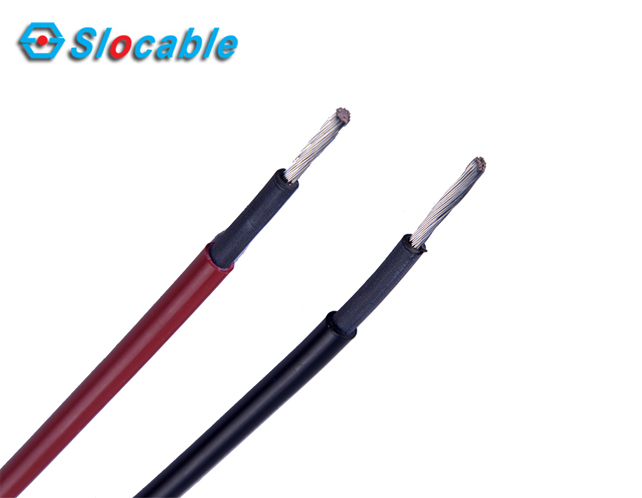
Photovoltaic wire, also known as PV wire, is a single conductor wire used to connect photovoltaic power system panels.
The conductor part of the photovoltaic cable is a copper conductor or a tin-plated copper conductor, the insulation layer is radiation crosslinked polyolefin insulation, and the sheath is radiation crosslinked polyolefin insulation. A large number of DC cables in photovoltaic power stations need to be laid outdoors, and the environmental conditions are harsh. The cable materials should be based on anti-ultraviolet, ozone, severe temperature changes and chemical erosion. It should be moisture-proof, anti-exposure, cold, heat-resistant, and anti-ultraviolet. In some special environments, chemical substances such as acid and alkali are also required.
Code Wiring Requirements
NEC (National Electrical Code of the United States) developed Article 690 Solar Photovoltaic (PV) systems to guide electrical energy systems, array circuits of photovoltaic systems, inverters and charge controllers. NEC is commonly used in various installations in the United States (local regulations may apply).
The 2017 NEC Article 690 Part IV wiring method allows various wiring methods to be used in photovoltaic systems. For single conductors, the use of UL-certified USE-2 (underground service entrance) and PV wire types are allowed in the exposed outdoor location of the photovoltaic power circuit in the photovoltaic array. It further allows PV cables to be installed in trays for outdoor PV source circuits and PV output circuits without the need for rated use. If the photovoltaic power supply and output circuit work above 30 volts in accessible locations, there are indeed limitations. In this case, an MC type or suitable conductor installed in the raceway is required.
NEC does not recognize Canadian model names, such as RWU90, RPV or RPVU cables that do not contain suitable dual UL certified solar applications. For installations in Canada, 2012 CEC Section 64-210 provides information on the types of wiring allowed for photovoltaic applications.
The difference between photovoltaic cables and ordinary cables
| |
Ordinary cable |
Photovoltaic cable |
| insulation |
Irradiation cross-linked polyolefin insulation |
PVC or XLPE insulation |
| jacket |
Irradiation cross-linked polyolefin insulation |
PVC sheath |
PV Advantages
The various materials that can be used for ordinary cables are high-quality interwoven link materials such as polyvinyl chloride (PVC), rubber, elastomer (TPE) and cross-linked polyethylene (XLPE), but it is a pity that the highest-rated temperature for ordinary cables In addition, even PVC insulated cables with a rated temperature of 70℃ are often used outdoors, but they cannot meet the requirements of high temperature, UV protection and cold resistance.
While photovoltaic cables are often exposed to sunlight, solar energy systems are often used in harsh environments, such as low temperature and ultraviolet radiation. At home or abroad, when the weather is good, the highest temperature of the solar system will be as high as 100℃.
——Anti-machine load
For photovoltaic cables, during installation and application, the cables can be routed on the sharp edges of the roof layout. At the same time, the cables must withstand pressure, bending, tension, interlaced tensile loads and strong impact resistance, which is superior to ordinary cables. If you use ordinary cables, the sheath has poor UV protection performance, which will cause the aging of the outer sheath of the cable, which will affect the service life of the cable, which can lead to the appearance of problems such as cable short circuit, fire alarm, and dangerous injury to employees. After being irradiated, the photovoltaic cable insulation jacket has high temperature and cold resistance, oil resistance, acid and alkali salt resistance, UV protection, flame retardancy, and environmental protection. Photovoltaic power cables are mainly used in harsh environments with a service life of more than 25 years.
Main Performance
1. DC resistance
The DC resistance of the conductive core of the finished cable at 20℃ is not more than 5.09Ω/km.
2. Water immersion voltage test
The finished cable (20m) will not breakdown after being immersed in (20±5)℃ water for 1h after 5min voltage test (AC 6.5kV or DC 15kV).
3. Long-term DC voltage resistance
The sample length is 5m, add (85±2)℃ distilled water containing 3% NaCl (240±2)h, and separate the water surface by 30cm. Apply a DC 0.9kV voltage between the core and the water (the conductive core is connected, and the water is connected to Nick). After taking out the sheet, perform a water immersion voltage test. The test voltage is AC 1kV, and no breakdown is required.
4. Insulation resistance
The insulation resistance of the finished cable at 20℃ is not less than 1014Ω·cm,
The insulation resistance of the finished cable at 90℃ is not less than 1011Ω·cm.
5. Surface resistance of sheath
The surface resistance of the finished cable sheath should not be less than 109Ω.
Performance Test
1. High-temperature pressure test (GB/T2951.31-2008)
Temperature (140±3)℃, time 240min, k=0.6, indentation depth does not exceed 50% of the total thickness of insulation and sheath. And carry out AC6.5kV, 5min voltage test, no breakdown is required.
2. Damp heat test
The sample is placed in an environment with a temperature of 90℃ and relative humidity of 85% for 1000h. After cooling to room temperature, the change rate of tensile strength is ≤-30% and the change rate of elongation at break is ≤-30% compared with before the test.
3. Acid and alkali resistance test (GB/T2951.21-2008)
The two groups of samples were immersed in oxalic acid solution with a concentration of 45g/L and sodium hydroxide solution with a concentration of 40g/L, at a temperature of 23°C for 168h. Compared with the solution before immersion, the tensile strength change rate was ≤±30 %, the elongation at break ≥100%.
4. Compatibility test
After the entire cable is aged for 7×24h at (135±2)℃, the change rate of tensile strength before and after insulation aging is ≤±30%, the change rate of elongation at break is ≤±30%; the change rate of tensile strength before and after the sheath is aging is ≤ -30%, change rate of elongation at break ≤±30%.
5. Low-temperature impact test (8.5 in GB/T2951.14-2008)
Cooling temperature -40℃, time 16h, weight of drop weight 1000g, weight of impact block 200g, height of drop 100mm, there should be no visible cracks on the surface.
6. Low temperature bending test (8.2 in GB/T2951.14-2008)
Cooling temperature (-40±2)℃, time 16h, the diameter of the test rod is 4 to 5 times the outer diameter of the cable, winding 3 to 4 times, after the test, there should be no visible cracks on the sheath surface.
7. Ozone resistance test
The length of the sample is 20cm, and it is placed in a drying vessel for 16h. The diameter of the test rod used in the bending test is (2±0.1) times the outer diameter of the cable. The test chamber: temperature (40±2)℃, relative humidity (55±5)%, ozone concentration (200±50)×10-6%, Air flow: 0.2 to 0.5 times the chamber volume/min. The sample is placed in the test box for 72 hours. After the test, there should be no visible cracks on the sheath surface.
8. Weather resistance/ultraviolet test
Each cycle: water spray for 18min, xenon lamp drying for 102min, temperature (65±3) ℃, relative humidity 65%, minimum power under the condition of wavelength 300~400nm: (60±2)W/m2. After 720 hours, a bending test at room temperature was carried out. The diameter of the test rod is 4 to 5 times the outer diameter of the cable. After the test, there should be no visible cracks on the sheath surface.
9. Dynamic penetration test
At room temperature, the cutting speed is 1N/s, and the number of cutting tests: 4 times. The sample must be moved forward by 25mm and rotated 90° clockwise each time. Record the penetration force F at the moment the spring steel needle contacts the copper wire, and the average value obtained is ≥150·Dn1/2N (4mm2 section Dn=2.5mm)
10. Resistant to dents
Take 3 sections of samples, each section is 25mm apart, and rotate 90° to make a total of 4 dents, the dent depth is 0.05mm and perpendicular to the copper wire. The three sections of samples were placed in a test box at -15°C, room temperature, and +85°C for 3 hours, and then wound on a mandrel in each corresponding test box. The diameter of the mandrel was (3±0.3) times the minimum outer diameter of the cable. At least one score for each sample is located on the outside. It does not break down in the AC0.3kV water immersion voltage test.
11. Sheath thermal shrinkage test (No. 11 in GB/T2951.13-2008)
The cut length of the sample is L1=300mm, placed in an oven at 120°C for 1 hour and then taken out to room temperature for cooling. Repeat this cooling and heating cycle 5 times, and finally cooling to room temperature. The thermal shrinkage of the sample is required to be ≤2%.
12. Vertical burning test
After the finished cable is placed at (60±2)°C for 4 hours, it is subjected to the vertical burning test specified in GB/T18380.12-2008.
13. Halogen content test
PH and conductivity
Sample placement: 16h, temperature (21~25)℃, humidity (45~55)%. Two samples, each (1000±5) mg, were crushed to particles below 0.1 mg. Air flow (0.0157·D2)l·h-1±10%, the distance between the combustion boat and the edge of the effective heating zone of the furnace is ≥300mm, the temperature at the combustion boat must be ≥935℃, 300m away from the combustion boat (in the direction of air flow ) The temperature must be ≥900℃.
The gas generated by the test sample is collected through a gas washing bottle containing 450ml (PH value 6.5±1.0; conductivity ≤0.5μS/mm) of distilled water. The test period: 30min. Requirements: PH≥4.3; conductivity ≤10μS/mm.




 2020-11-07
2020-11-07
















